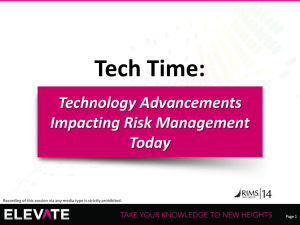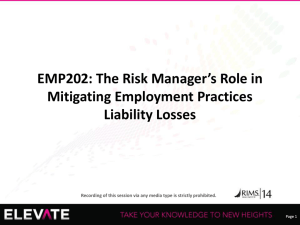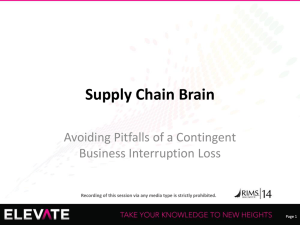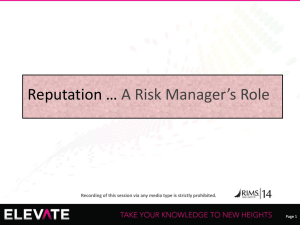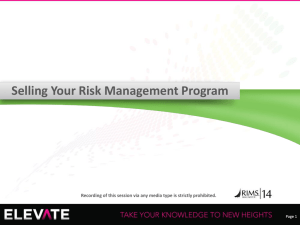Handout 1
advertisement
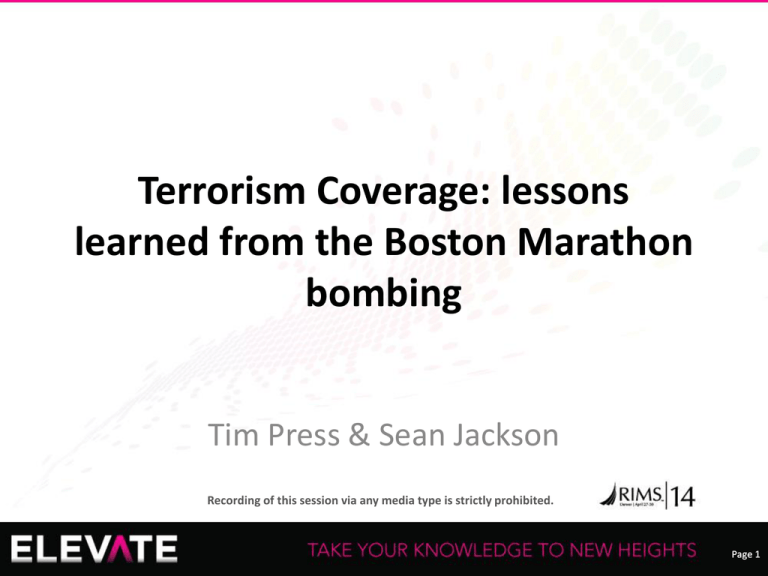
Terrorism Coverage: lessons learned from the Boston Marathon bombing Tim Press & Sean Jackson Recording of this session via any media type is strictly prohibited. Page 1 • Tim Press, Head of Special Risks, Miller Insurance Services LLP Tel: 011 44 20 7031 2685 Email: tim.press@miller-insurance.com Tim has worked in the insurance industry since 1988 and joined Miller in 1996. He is Head of the Special Risks team which covers product areas such as political risks, contract frustration, trade credit, terrorism, political violence and supply chain insurance. • Sean Jackson, Director, IMA Global Risk, IMA Corp. Tel: 913-982-3471 E-Mail: sean.jackson@imacorp.com Sean joined IMA in 2013 and has provided risk solutions to some of the largest global companies. As Director of IMA’s Global Risk Division, Sean is responsible for IMA’s multinational clients who travel, trade or have operations overseas. He has 22 years of experience assisting companies in managing their exposures all over the world. His unique experience and expertise crosses all industry segments and coverage lines. • Christine Hoppe, Risk Manager, CORAM Health Care Tel: 303-672-8746 Email: christine.hoppe@coramhc.com Christine has been a risk professional for over twenty years. In that time, she has worked for insurance carriers, brokers, TPAs and as a risk manager. When not is the office you will find her on the running trail. Christine also competed in the 2011 Boston Marathon. She is currently employed at CORAM Health Care (recently acquired by CVS). Recording of this session via any media type is strictly prohibited. Page 2 What to Expect After attending this session you will have gained an understanding of: • How the Boston bombings add to the TRIA debate • TRIA/TRIPRA • Alternatives to TRIA - stand-alone terror market and political violence • How to expand coverage for international exposures Recording of this session via any media type is strictly prohibited. Page 3 First – The Good News Recording of this session via any media type is strictly prohibited. Page 4 Boston Marathon bombing - timeline April 15, 2013 2.49pm: Two bombs detonated 15 block zone shut off by police Hunt for the Tsarnaev brothers April 19 –Boston is still in lockdown April 19, 8.50pm – one suspect dead, the other captured 1 2 3 4 5 6 Source: FBI/AP Source: Flicker by Aaron Tang licenced under CC BY 2.0 Source: Massachusetts State Police Air Wing Recording of this session via any media type is strictly prohibited. Page 5 Boston bombing in numbers • Property and casualty insurers paid a total of USD1.9m in bomb-related claims • Nearly half of 133 business interruption claims rejected • 11 of 27 claims for commercial property damage rejected • 72 hour exclusion Source: Division of Insurance 6 Recording of this session via any media type is strictly prohibited. Page 6 Did TRIA respond? • Some shops directly impacted by the bombings, such as the Forum restaurant on Bolyston Street, were still closed more than 45 days after the event • Stores on Bolyston Street that were undamaged by the blasts were closed for nine days as the FBI carried out their investigation into the bombings • Other businesses across Boston shut their doors as state authorities closed down the city’s transport system and issued a shelter-in-place order during the manhunt. • Tsarnaev brothers initially labelled terrorists by Obama and the media • However not classified as a “certified act of terrorism” • Leads to questions on process and timing of terrorism certification under TRIA. 7 Recording of this session via any media type is strictly prohibited. Page 7 Terrorism A dangerous world Recording of this session via any media type is strictly prohibited. 8 Page 8 Terrorism insurance pre 9/11/01 • Risks in various worldwide locations including: Middle East/ Israel o Sri Lanka o Colombia o South Africa o United Kingdom Spain Kenya Tanzania • Otherwise general “all risk” property cover included terrorism, excluded war • Some government programs/schemes: • Consorcio de Compensación de Seguros • Pool Re • SASRIA • Otherwise terrorism coverage written by the political risk market Recording of this session via any media type is strictly prohibited. 9 Page 9 Key US terror events pre 9/11 February 26, 1993 – New York Bomb explodes in garage of World Trade Center. Insured property losss – $822m fatalities 6 April 19, 1995 – Oklahoma City Truck bomb in front of government building Insured property loss: $192m fatalities 166 Oklahoma City National Memorial Source: Swiss Re & Insurance Information Institute (1) Includes bodily injury and aviation hull losses. Updated to 2013 dollars by the Insurance Information Institute using the U.S. Bureau of Labor Statistics CPI Inflation Calculator (2) Differs from inflation-adjusted estimates made by other organisations due to the use of different deflators Recording of this session via any media type is strictly prohibited. 10 Page 10 TRIA – overview • Terrorism Risk Insurance Act (2002) passed fourteen months after 9/11 as a federal backstop for insurance claims related to certified terrorism events • Terrorism Risk Insurance Program created – a risk-sharing plan between federal government and the insurance industry o o o o o o o 11 Created in response to commercial policyholders inability to secure terrorism coverage $100bn of annual reinsurance protection All commercial property and casualty policies to cover terrorism Year 1 – 27% businesses bought terrorism insurance By 2012 – 60% (higher in metropolitan areas) Reauthorised twice – 2002 and 2005 2014 – third time it has come up for reauthorisation Recording of this session via any media type is strictly prohibited. Page 11 Evolution of TRIA Acts which qualify under the program 2002 – TRIA (expired Dec 31, 2005) 2005 – TRIA extension (expired Dec 31, 2007) 2007 – TRIPRA (expiring Dec 31, 2014) Act of terrorism resulting in damage within the U.S. or to U.S. aircraft, ships or diplomatic missions. Individuals must have conducted the act of terrorism for the purpose of coercing the U.S. civilian population or influencing U.S. government policy. As at 2002 Distinction removed between foreign-domestic terrorism Lines covered Commercial P&C - Excess insurance - Workers’ compensation - Surety insurance Exclusions Personal lines, medical malpractice, title insurance, mortgage guaranty insurance, federal crop insurance, health insurance, life insurance, national flood insurance and financial guaranty insurance Amended Commercial P&C - Excess insurance - Workers’ compensation - D&O Additional exclusions: Commercial auto, burglary and theft, reinsurance and surety, professional indemnity (except D&O), farm owners multiple peril As at 2005 As at 2005 Program trigger USD5m After March 31, 2006 – USD50m 2007 – USD100m USD100m Insurance Marketplace Aggregate Retention Amount USD15b 2006 – USD25b 2007 – USD27.5 USD27.5 Post Trigger Federal Assistance 90% 85% 85% Individual Company Deductible (% of premiums) 7% 2006 – 17.5% 2007 – 20% 20% 12 Recording of this session via any media type is strictly prohibited. Page 12 Advantages/Disadvantages TRIA Advantages - TRIA Disadvantages - TRIA Stabilised the economy & market post 9/11 Untested regarding claims Carriers obliged to offer Relies on government certification Large limits available Uncertainty regarding process More capacity available in problem Only covers U.S. risks areas than stand-alone No developed stand-alone terrorism market for Workers Compensation 13 Pricing inconsistency Recording of this session via any media type is strictly prohibited. Page 13 Advantages/Disadvantages Stand-alone Terrorism Placement Advantages – stand alone Disadvantages - stand alone Clarity of coverage Limited capacity in “problem” zones (zip code aggregates) Breadth of coverage and global placement Proven claims payments and handling Capacity secured 14 Recording of this session via any media type is strictly prohibited. Page 14 Who is buying terrorism insurance? Industry sectors buying TRIA or stand-alone: • Real estate (91%) • Public sector & Financial entities (72%) • Media companies & entertainment (82%) • Tech firms (55%) • 75% of top 20 US brands are buying stand-alone terrorism coverage • Fortune 100 • > 70% of companies are buying stand-alone terrorism • > 55% of companies are buying global political violence Source: Interbrand & Miller research 2013 15 Recording of this session via any media type is strictly prohibited. Page 15 Stand-alone underwriting considerations • • • TIV and actual locations Management of underwriter aggregate Limit required • Highest aggregate areas nationwide (source: QBE Insurance (Europe) Ltd) • New York • • • • • • 16 Times Square /Rockerfeller Center / Wall Street/ NYSE ) Chicago, IL 60606/ 60611 San Francisco, CA Houston, Harris County Dallas, TX 75201 Seattle, WA 98188 Recording of this session via any media type is strictly prohibited. Page 16 How Terror risks are aggregated Source: QBE Insurance (Europe) Ltd Page 17 Recording of this session via any media type is strictly prohibited. Page 17 Denver ? Source: QBE Insurance (Europe) Ltd Recording of this session via any media type is strictly prohibited. Page 18 Terror in the US… Recording of this session via any media type is strictly prohibited. Source: QBE Insurance (Europe) Ltd Page 19 Why buy terrorism exclusively? US corporations with revenues of over $1bn have become more international with 70% having overseas property exposures Source: Miller research 2013 Paid claims • Lebanon War 2006 • 2010 Thai political protests • Egyptian Revolution of 2011 • Arab Spring • Westgate Mall Nairobi, Kenya 20 Recording of this session via any media type is strictly prohibited. Page 20 The devil is in the definition Recording of this session via any media type is strictly prohibited. 21 Page 21 TRIA renewal debate • • • • Policyholders are seeking and want alternatives Billions of dollars in private insurance capacity available Stand-alone offers coverage for companies with foreign exposures AM Best research re: non renewal of TRIA – only 4% of 220+ insurers examined failed the stress test, due mainly to workers compensation • Could a large-scale attack prove too costly for the private market – in absence of TRIA? • Nuclear and cyber coverages 22 Recording of this session via any media type is strictly prohibited. Page 22 TRIA outlook, rumours & uncertainty • • • • • • • All percentages, thresholds and retentions subject to change Possible inclusion of elements like cyber-terrorism coverage/NCBR Certification process redrafted ? Only workers comp cover, no property coverage Will likely renew with different coverage triggers Imminent or to the wire…. Many Firms are now looking to the stand alone market for alternatives and for certainty of coverage post December 31, 2014. Recording of this session via any media type is strictly prohibited. Page 23 US Terrorism coverage options • • • • Continue with property all risk / TRIA offering Secure with stand-alone terror option Combination of property all risk / TRIA & stand alone coverage TRIA captive wrap with options. • Capacity commitment if TRIA coverage is already in place 24 Recording of this session via any media type is strictly prohibited. Page 24 Conclusion • • • • • 25 Terrorism is a persistent threat – over 200 attacks in the USA between 2001-2012 Boston bombing aftermath shows that TRIA leaves some questions Market has shown it is able to cope with large-scale losses, e.g. Hurricane Katrina TRIA, what next and uncertainty Look at other options to cover your U.S. and international exposures Recording of this session via any media type is strictly prohibited. Page 25 Questions & Final Comments The future of TRIA? Recording of this session via any media type is strictly prohibited. Page 26 KEEP THIS SLIDE FOR EVALUATION INFORMATION/MOBILE APP ETC. Please complete the session survey on the RIMS14 mobile application. Recording of this session via any media type is strictly prohibited. Page 27 Terrorism coverage: lessons learned from the Boston Marathon bombing Tim Press & Sean Jackson Recording of this session via any media type is strictly prohibited. Page 28

